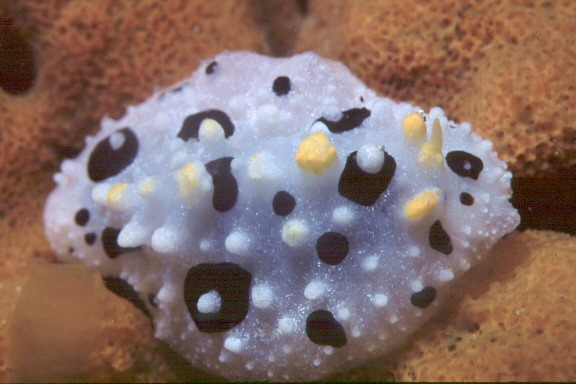
Phyllidia babai
Phyllidia babai Brunckhorst 1993
Many species of dorid-like nudibranchs including members of the Family Phyllidiidae are difficult to distinguish because of colour mimicry across species and colour variation within a species. Terry Gosliner, Bill Rudman and myself amongst others, have discussed aposematism or 'warning coloration' in nudibranchs; it even appears that some marine flatworms may mimic phyllidiids!! Warning coloration involves being distasteful (or poisonous) to eat and advertising the fact to your potential predators (as some butterflys do). Anyway, this means that different species try to look the same (to spread the benefit of being recognised as bad to eat!); but, this is further complicated by individual variation within a species!
Hence it is sometimes useful to think of 'colour groups' of species. The 'Phyllidia ocellata colour group' is a particularly complex one having slugs with yellow-orange tubercles and/or dorsum with 'eye patches' surrounded in white and or black with a tubercle (usually yellow) in the middle. While P. ocellata displays some individual variation some other distinct species occur in the colour group.
P. babai belongs to this group. It is distinguishable by its consistently white dorsum with fine yellow margin and narrow tubercles; it has the black 'eye patches' as other species in the group. There are other distinguishing features such as its white foot (dark gray in ocellata) and in internal morphology and morphology of penial spines.
P. babai is known from the western pacific; it feeds on the yellow sponge, Acanthella stipata Carter 1881. This nudibranch was named in honour of a grand gentleman of Opisthobranch taxonomy and biology in Japan, Kikutaro Baba.

|
Dr. David J. Brunckhorst Director, Institute for Bioregional Resource Management Division of Ecosystem Management University of New England Armidale NSW 2351 Australia
Send David mail at dbrunckh@metz.une.edu.au
Visit David's web page at Dave's Page |
For those of you interested in the photographic background information of the images, the following may be of interest!
Camera System: Tussey T-300 underwater housing with FM-2/Nikon 60mm lens.
Strobe: Ikelite Ai
Film: Fuji Velvia
Site: Batangas, Philippines
Photo Editing: PhotoStyler 2.0 on 486 DX-2 33 mhz/ 64 megs RAM
